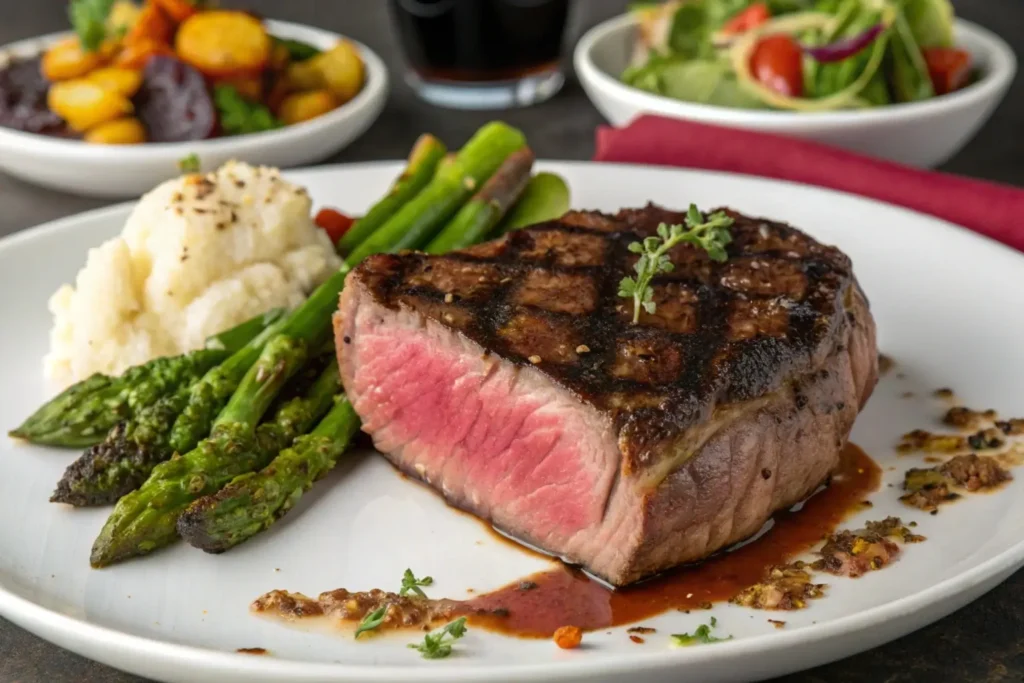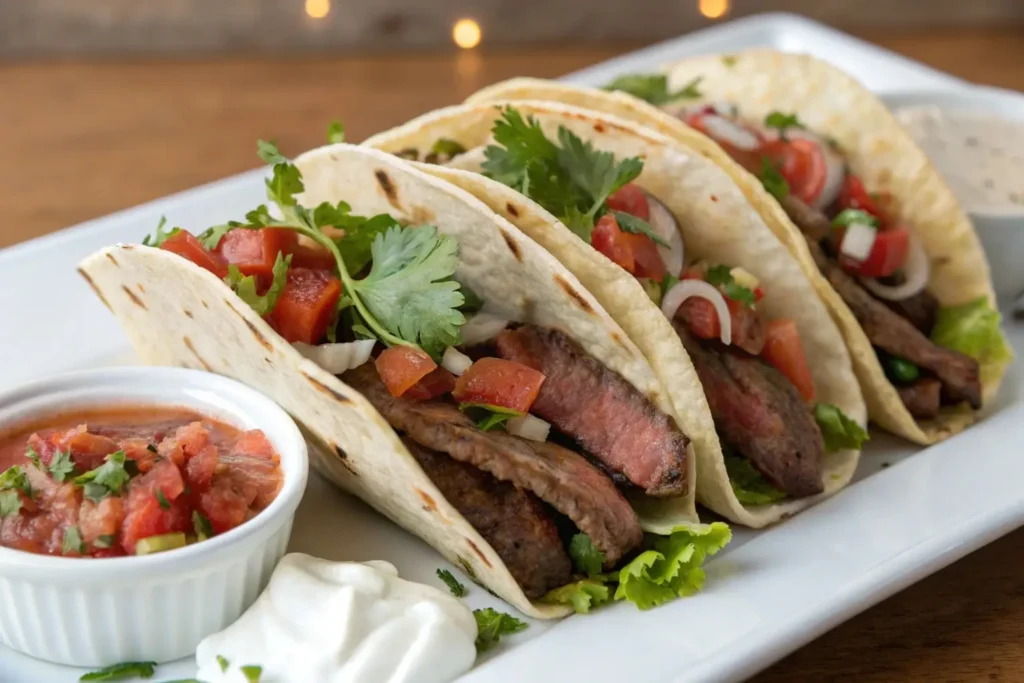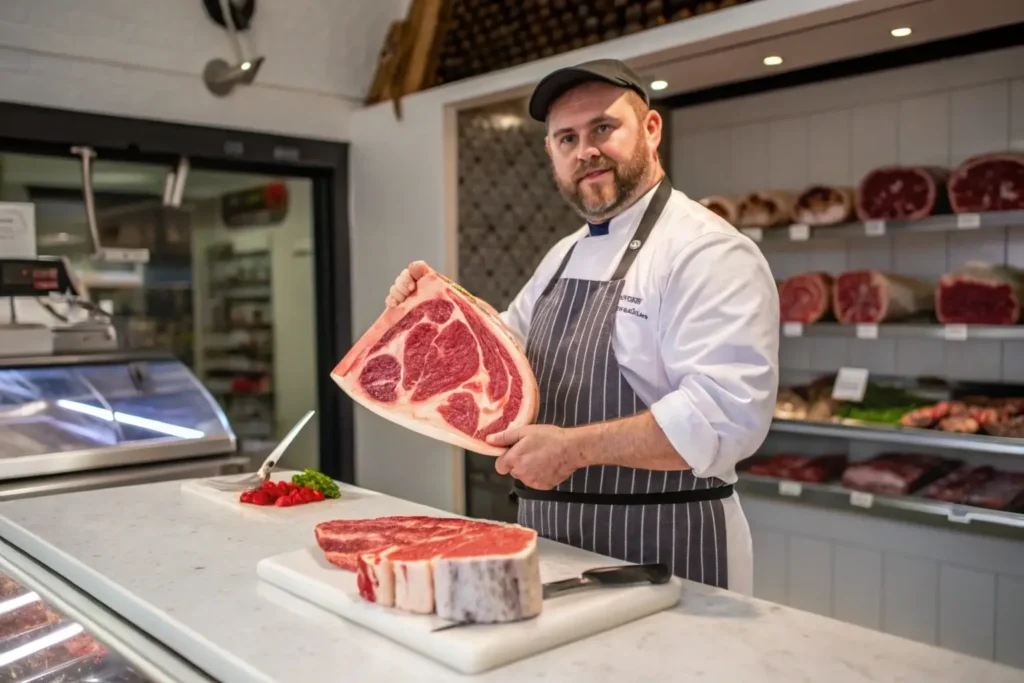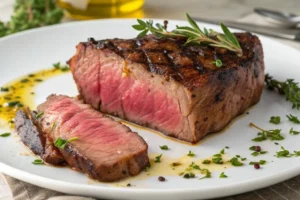Table of Contents
Imagine sinking your teeth into a steak so tender and flavorful, it feels like pure indulgence. That’s the spinalis steak, often called the “crown jewel” of steaks. Also known as the ribeye cap, this luxurious cut is prized for its exceptional marbling, buttery texture, and rich flavor profile. Though it’s a lesser-known gem among casual steak eaters, culinary enthusiasts and chefs have celebrated it as one of the most exquisite parts of a ribeye.
This guide will unravel everything you need to know about the spinalis steak, from its origins and flavor to the best cooking methods and recipes. Whether you’re a seasoned grill master or a curious foodie, this article will inspire you to explore the magic of the ribeye cap.
What is Spinalis Steak?
Spinalis steak is not your typical cut of beef. It’s the cap of the ribeye, located along the top of the ribeye primal, encasing the eye of the ribeye. This cut is celebrated for its intense marbling, which enhances its flavor and juiciness. Unlike the eye of the ribeye, which is leaner and denser, the spinalis boasts a tender, melt-in-your-mouth texture.
If you’re wondering how spinalis steak compares to other popular cuts like filet mignon or sirloin, here’s a quick breakdown:
- Filet mignon: Extremely tender but milder in flavor.
- Sirloin: Offers a bold flavor but lacks the marbling and tenderness of the spinalis.
- Ribeye cap (spinalis): The perfect combination of intense beefy flavor and luxurious texture.
The rarity of this cut adds to its allure—it’s not something you’ll find in every steakhouse or grocery store. But once you’ve tasted it, it’s easy to see why many steak aficionados consider it the ultimate treat.
Flavor and Texture
What sets spinalis steak apart is its unrivaled flavor and texture. Thanks to its exceptional marbling, every bite bursts with juicy, beefy richness. The fat within the cut melts during cooking, creating a silky mouthfeel that’s hard to match. Its tenderness is another standout feature; you can practically cut it with a fork.
But the real magic lies in its flavor profile. The ribeye cap delivers a robust, savory taste with subtle buttery undertones, making it a showstopper for steak lovers. Pair this with the right seasoning and a perfect sear, and you’ve got a dish that’s nothing short of spectacular.
Why Spinalis Steak is So Popular
The spinalis steak is a rare treasure in the world of beef, celebrated for its luxurious qualities. Its growing popularity can be attributed to several factors:
1. Rarity and Exclusivity
The spinalis is a limited cut of beef, as it comes only from the ribeye primal. This exclusivity makes it highly sought-after among steak enthusiasts who enjoy savoring something unique.
2. Chef and Foodie Endorsements
Celebrity chefs often highlight spinalis steak in their restaurants and cooking shows, praising it as one of the finest cuts available. Its reputation as a “steak lover’s steak” has been bolstered by glowing reviews in food blogs and media.
3. Unmatched Flavor Profile
When it comes to flavor, the ribeye cap stands alone. Its rich marbling creates a buttery taste that can elevate any dining experience, making it a favorite for both home cooks and professionals.
If you’re a fan of premium, high-quality beef, it’s no wonder this steak is on your radar. But what’s next? It’s time to learn how to choose the perfect cut.
How to Choose the Perfect Spinalis Steak
Selecting the right spinalis steak can make all the difference in your dining experience. Here’s what to keep in mind:
1. Marbling is Key
Look for steaks with abundant marbling. These white streaks of fat running through the meat enhance its flavor and juiciness. The more evenly distributed the marbling, the better.
2. Thickness and Size
A good spinalis steak should have a uniform thickness of at least one inch to ensure even cooking. Avoid cuts that are too thin, as they might dry out during the cooking process.
3. Sourcing Matters
Grass-fed beef offers a slightly leaner taste with earthy undertones, while grain-fed beef is typically richer and more buttery. Choose based on your flavor preference, but ensure it’s sourced from a reputable butcher or supplier.
4. Freshness and Color
The steak should have a vibrant red color, indicating freshness. Avoid any cuts with brown or gray patches, as these could signal that the meat is past its prime.
Preparing Spinalis Steak
One of the joys of spinalis steak is how simple it is to prepare. With such a flavorful cut, less is often more. Follow these tips to get the most out of your steak:
1. Seasoning Simplicity
A sprinkle of salt and pepper is all you need to let the natural flavors shine. For added depth, you can include garlic powder, smoked paprika, or a touch of fresh herbs.
2. Rest Before Cooking
Let the steak sit at room temperature for 30–60 minutes before cooking. This ensures it cooks evenly and retains its juiciness.
3. Pat it Dry
Use paper towels to blot the steak dry before cooking. This step helps achieve that perfect crust during searing.
4. Oil Wisely
Use high-smoke-point oils like avocado or grapeseed oil to avoid burning during cooking. A light coat is all you need to prevent sticking.
Best Cooking Methods for Spinalis Steak
The spinalis steak’s rich marbling and tender texture make it ideal for several cooking methods. Whether you prefer a crisp crust from a hot skillet or the smoky essence of the grill, these techniques will help you bring out its best qualities.
1. Pan-Searing: A Perfect Crust
Pan-searing is one of the simplest and most effective ways to cook spinalis steak. It delivers a flavorful crust while keeping the interior juicy and tender.
Step-by-Step Guide:
- Preheat the Pan: Heat a cast-iron skillet over medium-high heat until it’s scorching hot.
- Add Oil: Use a high-smoke-point oil like avocado or canola oil to coat the pan lightly.
- Sear the Steak: Place the steak in the pan and cook for 2–3 minutes per side until a golden-brown crust forms.
- Finish with Butter and Aromatics: Add a pat of butter, garlic cloves, and fresh thyme or rosemary to the pan. Baste the steak with the melted butter for extra flavor.
- Rest the Steak: Remove the steak from the pan and let it rest for 5–10 minutes before slicing.
2. Grilling: Smoky Perfection
Grilling brings a smoky, charred flavor that complements the ribeye cap’s richness.
How to Grill Spinalis Steak:
- Preheat the Grill: Heat your grill to high, creating both direct and indirect heat zones.
- Season the Steak: Apply salt, pepper, and a touch of olive oil to the steak.
- Sear Over Direct Heat: Place the steak on the direct heat zone for 2–3 minutes per side to achieve grill marks.
- Finish Over Indirect Heat: Move the steak to the cooler side of the grill and cook until it reaches your desired doneness (use a meat thermometer for accuracy).
- Rest Before Serving: Let the steak rest briefly to lock in its juices.
3. Sous Vide: Precision Cooking
Sous vide is perfect for achieving even doneness throughout the steak while preserving its tenderness.
Steps for Sous Vide Spinalis Steak:
- Prepare the Steak: Season the steak and place it in a vacuum-sealed bag with a sprig of thyme or a clove of garlic.
- Set the Temperature: Heat your sous vide machine to 129°F (54°C) for medium-rare.
- Cook the Steak: Submerge the bag in the water bath and cook for 1.5–2 hours.
- Sear for a Crust: After sous vide cooking, sear the steak in a hot pan for 1–2 minutes per side to develop a caramelized crust.
Pairing Spinalis Steak with Sides

A meal is only as good as its accompaniments. With the ribeye cap’s rich flavor, you’ll want sides that balance or enhance its profile. Here are some stellar pairing ideas:
Classic Side Dishes
- Creamy Mashed Potatoes: The buttery smoothness complements the steak’s juiciness.
- Roasted Asparagus: Adds a fresh, earthy contrast to the steak’s richness.
- Garlic Butter Mushrooms: Their umami pairs beautifully with the beefy flavors.
Creative Twists
- Truffle Mac and Cheese: A decadent option for indulgence seekers.
- Grilled Corn with Chili Lime Butter: A zesty side that balances the steak’s fattiness.
- Arugula Salad with Lemon Vinaigrette: The peppery greens and tangy dressing provide a refreshing bite.
Link to Classic Restaurant Caesar Salad to find a perfect side dish for your steak dinner.
Common Mistakes to Avoid When Cooking Spinalis Steak
Even with such a perfect cut, mistakes can detract from its potential. Avoid these pitfalls for a flawless meal:
- Overcooking the Steak
Spinalis steak is best enjoyed medium-rare to medium. Overcooking can dry out its luscious marbling, diminishing the flavor and texture. - Skipping the Resting Step
Letting the steak rest allows the juices to redistribute. Cutting too soon can lead to a loss of moisture and flavor. - Using Low Heat
A high-temperature sear is crucial for caramelization and that golden crust. Avoid cooking the steak at low temperatures unless you’re using sous vide.
Nutritional Information and Benefits of Spinalis Steak
The spinalis steak is not just about indulgence; it also packs a nutritional punch. Like most beef cuts, it is rich in essential nutrients that contribute to a balanced diet.
Macronutrient Breakdown
Here’s an approximate nutritional profile for a 3.5-ounce (100-gram) serving of spinalis steak (varies slightly depending on preparation and fat content):
- Calories: 250–300
- Protein: 24–28 grams
- Fat: 18–22 grams
- Carbohydrates: 0 grams
Key Nutritional Benefits
- High in Protein
Protein is essential for muscle growth, repair, and overall body function. A single serving of spinalis steak provides over 40% of the daily recommended intake for an average adult. - Rich in Iron
Iron in beef is heme iron, which is more easily absorbed by the body compared to plant-based sources. It supports oxygen transportation in the blood and helps prevent anemia. - Packed with Zinc
Zinc aids in immune system function, wound healing, and cellular repair. Spinalis steak is an excellent source of this vital mineral. - Loaded with B Vitamins
It’s particularly high in B12, which is crucial for energy production, brain health, and red blood cell formation. Other B vitamins, like niacin and riboflavin, support skin health and digestion. - Contains Healthy Fats
The intramuscular fat, or marbling, provides a source of monounsaturated fats, similar to those found in avocados and olive oil. These fats can support heart health when consumed in moderation.
Cost and Availability
Spinalis steak is one of the most luxurious cuts of beef, and its price and availability reflect that exclusivity. Here’s what you need to know:
Why It’s Expensive
- Limited Supply:
Only a small portion of the ribeye primal is spinalis, making it a rare find. - High Demand:
As its reputation grows, more steak lovers and chefs are vying for this prized cut.
Where to Find It
- Specialty Butchers:
Local butcher shops are often the best source for spinalis steak. Call ahead to check availability. - High-End Grocers:
Stores like Whole Foods or specialty meat purveyors may carry this cut. - Online Retailers:
Many gourmet meat suppliers sell spinalis steak online, shipped fresh or frozen.
Tips for Finding Deals
- Shop during sales or promotions at your local butcher.
- Buy ribeye primal cuts and trim the spinalis steak yourself (this requires some knife skills but can save money).
Spinalis Steak in Popular Culture
The spinalis steak has earned a luxurious reputation, making appearances in high-end restaurants, cooking shows, and gourmet food discussions.
Culinary Shows and Blogs
Celebrity chefs like Gordon Ramsay and Bobby Flay have highlighted the ribeye cap for its unbeatable flavor. It’s often showcased in cooking challenges on shows like MasterChef and Top Chef.
Famous Dishes
Many Michelin-starred restaurants have featured spinalis steak on their menus, often served simply with a drizzle of herb butter or paired with exotic sides to highlight its natural taste.
Social Media Buzz
Food influencers and steak enthusiasts frequently showcase spinalis steak in their posts, creating a buzz about this luxurious cut. Its eye-catching marbling makes it a visual treat for food photography.
Recipe Ideas for Spinalis Steak

The versatility of spinalis steak makes it a favorite for chefs and home cooks alike. Whether you’re preparing a simple, elegant dinner or experimenting with bold flavors, these recipe ideas will elevate your culinary repertoire.
1. Simple Grilled Spinalis Steak Recipe
This recipe highlights the natural flavors of the ribeye cap with minimal seasoning and a perfect sear.
Ingredients:
- 2 spinalis steaks (8–10 oz each)
- Salt and freshly ground black pepper
- 1 tbsp olive oil
- 2 cloves garlic, smashed
- 2 sprigs fresh rosemary or thyme
Instructions:
- Prepare the Steaks: Pat the steaks dry with paper towels. Season generously with salt and pepper on both sides.
- Preheat the Grill: Heat your grill to medium-high. Oil the grates lightly to prevent sticking.
- Sear the Steaks: Place the steaks on the grill and sear for 2–3 minutes per side.
- Finish Indirectly: Move the steaks to indirect heat, cover the grill, and cook for 4–6 more minutes, depending on your preferred doneness.
- Rest and Serve: Let the steaks rest for 5 minutes. Garnish with garlic and rosemary for an aromatic touch.
2. Ribeye Cap with Herb Butter
For a decadent twist, top the spinalis steak with a homemade herb butter.
Ingredients:
- 2 spinalis steaks
- Salt and pepper
- 3 tbsp unsalted butter, softened
- 1 tbsp parsley, finely chopped
- 1 tsp lemon zest
- 1 garlic clove, minced
Instructions:
- Make the Herb Butter: Combine softened butter, parsley, lemon zest, and garlic in a bowl. Mix well and refrigerate until firm.
- Cook the Steaks: Pan-sear or grill the spinalis steaks following the earlier methods.
- Top with Butter: While the steak is resting, place a dollop of herb butter on top. It will melt into the meat, enhancing its flavor.
3. Spinalis Steak Tacos
For a fun and flavorful twist, transform spinalis steak into tender, juicy taco filling.
Ingredients:
- 1 spinalis steak (about 10 oz)
- 1 tbsp taco seasoning
- 1 tbsp olive oil
- Warm corn tortillas
- Toppings: diced onions, cilantro, avocado slices, lime wedges
Instructions:
- Season the Steak: Rub the steak with taco seasoning and olive oil. Let it marinate for 30 minutes.
- Cook and Slice: Grill or pan-sear the steak until medium-rare, then slice thinly against the grain.
- Assemble Tacos: Fill each tortilla with steak slices and desired toppings. Squeeze fresh lime juice over each taco before serving.
Frequently Asked Questions (FAQs)

1. What makes spinalis steak different from ribeye?
While the ribeye includes several muscles, the spinalis steak is the cap of the ribeye. It’s more tender and flavorful due to its marbling and softer texture.
2. How do I store spinalis steak?
Store fresh spinalis steak in the refrigerator for up to 3 days. For longer storage, wrap it tightly in plastic wrap and freeze for up to 6 months.
3. Can I substitute spinalis steak for other cuts in recipes?
Yes, spinalis steak can replace ribeye, filet mignon, or sirloin in recipes. However, its unique tenderness and flavor make it stand out in simple preparations.
4. What’s the best way to reheat spinalis steak?
To avoid overcooking, reheat spinalis steak gently. Place it in a preheated oven at 250°F for 10–15 minutes or use a skillet with a touch of oil over low heat.
5. Why is spinalis steak so expensive?
Its rarity and the fact that only a small portion of the ribeye primal yields spinalis steak contribute to its higher price. Its flavor and texture also justify the cost.
6. Is spinalis steak good for grilling?
Absolutely! Its rich marbling and natural tenderness make it ideal for grilling, delivering a smoky, charred flavor while maintaining juiciness.
Spinalis Steak: The Ultimate Guide to the Ribeye Cap
Equipment
- Grill or Cast Iron Skillet
- Meat Thermometer
- Sharp Knife
Ingredients
Spinalis Steak
- 2 pieces spinalis steaks (ribeye cap) 8-10 oz each
Seasoning
- 1 tsp salt to taste
- 1 tsp black pepper freshly ground
- 1 tbsp olive oil
- 2 cloves garlic smashed
- 2 tbsp unsalted butter
- 2 sprigs fresh rosemary or thyme
Instructions
- Pat the spinalis steaks dry with paper towels. Season generously with salt and freshly ground black pepper.
- Let the steaks sit at room temperature for 30 minutes before cooking to ensure even cooking.
- Preheat a grill or cast iron skillet over medium-high heat. Add a tablespoon of olive oil.
- Place the steaks in the skillet or on the grill. Sear for 2-3 minutes per side until a golden-brown crust forms.
- Reduce heat to medium. Add butter, smashed garlic cloves, and fresh rosemary or thyme to the pan. Baste the steaks with the melted butter for extra flavor.
- Cook until the internal temperature reaches 130°F (54°C) for medium-rare or 135°F (57°C) for medium.
- Remove the steaks from heat and let them rest for 5-10 minutes before slicing.
- Slice against the grain and serve immediately.
Notes
Conclusion
The spinalis steak, or ribeye cap, is a true gem in the world of beef. Its luxurious texture, rich marbling, and robust flavor make it a must-try for steak enthusiasts. Whether you prefer it grilled, pan-seared, or paired with creative sides, this cut promises an unforgettable dining experience. With the right preparation, you can transform this rare cut into a show-stopping centerpiece for any meal.
For steak preparation tips: Link to How to Cook Thanksgiving Dinner from Start to Finish for guidance on managing large, complex meals.
For understanding beef cuts: Link to Understanding the Different Types of Beef Bones and Their Culinary Uses to delve deeper into the versatility of beef cuts.
- Tropical Pineapple Salsa -Fresh, Flavorful, and Easy to Make
- Homemade Salsa for Canning – Honeybunch Hunts
- Easy Homemade Salsa Verde | Complete Guide
- Black Bean Corn Salsa – Fresh and Flavorful Recipe
- Pineapple Salsa That Wows at Every Party

